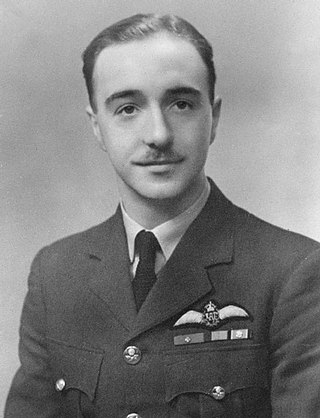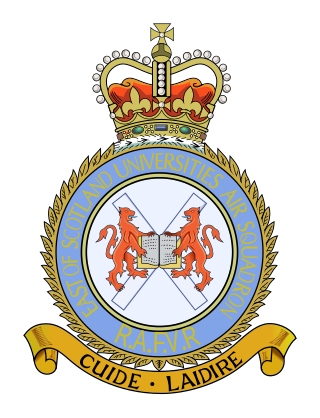Related Research Articles

The British Commonwealth Air Training Plan (BCATP), or Empire Air Training Scheme (EATS) often referred to as simply "The Plan", was a massive, joint military aircrew training program created by the United Kingdom, Canada, Australia and New Zealand, during the Second World War. BCATP remains one of the single largest aviation training programs in history and was responsible for training nearly half the pilots, navigators, bomb aimers, air gunners, wireless operators and flight engineers who served with the Royal Air Force (RAF), Royal Navy Fleet Air Arm (FAA), Royal Australian Air Force (RAAF), Royal Canadian Air Force (RCAF) and Royal New Zealand Air Force (RNZAF) during the war.

The Avro Anson is a British twin-engine, multi-role aircraft built by the aircraft manufacturer Avro. Large numbers of the type served in a variety of roles for the Royal Air Force (RAF), Fleet Air Arm (FAA), Royal Canadian Air Force (RCAF), Royal Australian Air Force and numerous other air forces before, during, and after the Second World War.

The Airspeed AS.10 Oxford is a twin-engine monoplane aircraft developed and manufactured by Airspeed. It saw widespread use for training British Commonwealth aircrews in navigation, radio-operating, bombing and gunnery roles throughout the Second World War.
An aviator badge is an insignia used in most of the world's militaries to designate those who have received training and qualification in military aviation. Also known as a pilot's badge, or pilot wings, the aviator badge was first conceived to recognize the training that military aviators receive, as well as provide a means to outwardly differentiate between military pilots and the “foot soldiers” of the regular ground forces.

A trainer is a class of aircraft designed specifically to facilitate flight training of pilots and aircrews. The use of a dedicated trainer aircraft with additional safety features—such as tandem flight controls, forgiving flight characteristics and a simplified cockpit arrangement—allows pilots-in-training to safely advance their skills in a more forgiving aircraft.

William Reid was a Scottish recipient of the Victoria Cross, the highest and most prestigious award for gallantry in the face of the enemy that can be awarded to British and Commonwealth forces. He earned his Victoria Cross as a pilot in the Royal Air Force Bomber Command during the Second World War.

An aircrew flying badge is the badge worn on the left breast, above any medal ribbons, by qualified aircrew in the Royal Air Force, Royal Navy, British Army, Indian Air Force, Pakistan Air Force, Royal Canadian Air Force, Royal Australian Navy, Australian Army, Royal Australian Air Force, Royal New Zealand Air Force, South African Air Force and Sri Lanka Air Force. An example of a real pilot brevet is as opposite:

The Way to the Stars is a 1945 Anglo-American black-and-white Second World War drama film made by Two Cities Films. The film was produced by Anatole de Grunwald, directed by Anthony Asquith, and stars Michael Redgrave, John Mills, Rosamund John, and Stanley Holloway. In the United States it was shortened by 22 minutes, and the shortened version was distributed by United Artists under the title Johnny in the Clouds.

A Weapon Systems Officer (WSO), nicknamed "Wizzo", is an air flight officer directly involved in all air operations and weapon systems of a military aircraft.

The East of Scotland Universities Air Squadron, commonly known as ESUAS, is a squadron within the Royal Air Force established in 2003 as an amalgamation of "East Lowlands Universities Air Squadron" (ELUAS) and "Aberdeen, Dundee and St Andrews Universities Air Squadron" (ADStAUAS). It is based at Leuchars Station, in Fife and flies a fleet of six Grob Tutor aircraft. ESUAS is the parent Squadron of No. 12 Air Experience Flight RAF, who share the aircraft.

The 12th Operations Group is the flying component of the 12th Flying Training Wing of United States Air Force's Air Education and Training Command. The group headquarters is located at Randolph Air Force Base, Texas.. The unit's main missions include aircraft instructor pilot training in Beechcraft T-6 Texan II, Northrop T-38C Talon and Raytheon T-1 Jayhawk aircraft, Air Force and Navy undergraduate combat systems officer training and fighter fundamentals student pilot instructor training in the Northrop AT-38C.
Royal Air Force Sutton Bridge or more simply RAF Sutton Bridge is a former Royal Air Force station found next to the village of Sutton Bridge in the south-east of Lincolnshire. The airfield was to the south of the current A17, and east of the River Nene, next to Walpole in Norfolk.

The Bermuda Flying School operated on Darrell's Island from 1940 to 1942. It trained Bermudian volunteers as pilots for the Royal Air Force and the Fleet Air Arm.

Royal Air Force Film Production Unit produced propaganda films depicting RAF personnel and aircraft both on the ground and in aerial action during World War II from 1941 to 1945.

The aircrews of RAF Bomber Command during World War II operated a fleet of bomber aircraft carried strategic bombing operations from September 1939 to May 1945, on behalf of the Allied powers. The crews were men from the United Kingdom, other Commonwealth countries, and occupied Europe, especially Poland, France, Czechoslovakia and Norway, as well as other foreign volunteers. While the majority of Bomber Command personnel were members of the RAF, many belonged to other air forces – especially the Royal Canadian Air Force (RCAF), Royal Australian Air Force (RAAF) and Royal New Zealand Air Force (RNZAF). Under Article XV of the 1939 Air Training Agreement, squadrons belonging officially to the RCAF, RAAF, and RNZAF were formed, equipped and financed by the RAF, for service in Europe. While it was intended that RCAF, RAAF, and RNZAF personnel would serve only with their respective "Article XV squadrons", in practice many were posted to units of the RAF or other air forces. Likewise many RAF personnel served in Article XV squadrons.

Group Captain Thomas Gilbert "Hamish" Mahaddie, was a Scotsman who served in the Royal Air Force (RAF). As a youth he was selected for an apprentice programme and was trained as an RAF ground crew "metal rigger". He had earned his wings and reached the rank of sergeant pilot by the outbreak of the Second World War. In his second tour he was selected to be a member of the newly formed "Pathfinder Force". At the end of his second combat tour he was brought onto Air Vice Marshal Don Bennett's Headquarter Staff in the position of "Group Training Inspector". In this position he selected, recruited and trained aircrews to serve in the Pathfinder Force. Within the span of two years from the start of the war Mahaddie had risen in rank from sergeant to group captain. Following the war he continued to serve in the RAF until 1958. Out of the service he worked as an electronics consultant for the Armed Services, and as an aircraft consultant for the film industry. His most remarkable accomplishment in the film industry was the procurement of aircraft, crews and service personnel for the film Battle of Britain (1969).

John Anthony Logan Currie, was an officer in the Royal Air Force (RAF) and an author. After serving during the Second World War, he stayed on in the RAF and attained the rank of squadron leader. After he left the service he wrote a number of books on the RAF, three of which described his own experiences as a bomber pilot. His books portray life as it was in RAF Bomber Command during the course of the Second World War. Currie served as narrator in three BBC documentaries on the air war over Europe.
John Jellicoe Blair, DFC (1919-2004) was a Jamaican Royal Air Force (RAF) pilot and navigator for RAF Bomber Command during the Second World War. Having been assigned to 102 (Ceylon) Squadron in December 1944, he navigated Halifax Bombers.
References
- ↑ "Journey Together (1945)". BFI. Archived from the original on 3 November 2017.
- ↑ "Looking for Flying Officer Rattigan, Group Captain Clive Montellier RAF, 2013" (PDF). The Terence Rattigan Society. Retrieved 3 November 2021.
- ↑ Gifford, Denis, ed. (1 April 2016). British Film Catalogue. Vol. 2. Routledge. p. 530. ISBN 978-1-317-74063-6.
- ↑ Murphy, Robert (2 September 2003). Realism and Tinsel: Cinema and Society in Britain 1939–48. Routledge. p. 208. ISBN 978-1-134-90150-0.